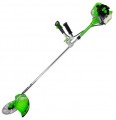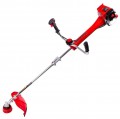Cutting width
The capture width provided by the unit, in other words, the width of the strip of land cultivated in one pass. In fact, this size corresponds to the width of the working nozzle.
The large working width is useful when processing large open spaces, as it allows you to finish the job in a small number of passes. On the other hand, for hard-to-reach places, relatively narrow tools are better suited, able to go where a wider unit will not fit. In addition, the width of the tool directly affects the weight and price.
In general, it makes sense to compare in terms of working width only units of the same type (see above). However, it is worth noting here that trimmers do not differ so much from each other — most models capture from 25 to 45 cm (and a wide processing band is provided by moving the nozzle from side to side). As for the other types, in the most modest models the capture width
does not exceed 40 cm, in the heaviest and most powerful it can be
56 – 60 cm or even
more(in mini tractors — up to 1.5 m).
Trimmer blade width
The width (diameter) of the trimmer knife characterizes the size of the paddle knife (or saw blade). Such a nozzle has a smaller capture width than a fishing line, however, it allows you to mow more dense thickets, including shrubs.
Line diameter
The diameter of the fishing line supplied with the trimmer (more precisely, with a reel attachment, see "Tips").
In modern models, this parameter can be from 1 to 4 mm. At the same time, a thicker fishing line handles better with dense thickets, but it works rougher, the treated lawn is not particularly even, and for the effective operation of such a nozzle, a fairly powerful engine is needed. On the other hand, a fine line provides a clean and neat cut, but is not suitable for heavy vegetation and large stems. Thus, thick fishing line is usually equipped with powerful units designed for "launched" lawns with an abundance of thick stems. Thin, on the other hand, is found mainly in low-power electric trimmers with a lower engine location, designed for neat lawns with regularly cut grass.
We also recall that many trimmers have the ability to replace the standard reel with another one that differs in line thickness.
More features
—
Adjustment of the tilt of the rod. Possibility to tilt the rod or the working head relative to the rod. The setting will come in handy for mowing grass in hard-to-reach places. Trimmers with this function are much more convenient to work under swings, benches and garden furniture. Also, by adjusting the tilt of the rod, you can adjust the grip of the trimmer to the height of the user.
—
Telescopic rod. Possibility of increasing the length of the trimmer by extending the rod. Due to design features, this solution is available only for models with a lower engine and helps to maximally adjust the device for a person of any height.
—
Collapsible rod. Possibility to disassemble the trimmer rod into several parts. This feature greatly simplifies storage and transportation: packing, carrying and transporting side-by-side components is easier than a solid long rod. In theory, this design is less reliable than a non-removable design, but trimmers are usually not subjected to such high loads that this would be noticeable.
-
Belt. The strap for carrying the trimmer is
a shoulder or
backpack strap. This design significantly simplifies the operator’s task and reduces operator fatigue: carrying it with a belt is not as tiring as holding the tool in your
...hands. The shoulder strap is supposed to be worn over one shoulder. It helps you control the trimmer better and reduces fatigue, especially during long periods of use. A more complex backpack strap system allows you to distribute the weight of the tool on both shoulders and back. In this implementation, the belt will not slip off the shoulder when wearing the trimmer. Please note that in models without a belt, it may be possible to purchase it separately. However, it is easier (and often cheaper) to immediately buy a tool with this accessory.
— Limit bracket. The bracket acts as a limiter and is designed to protect tall (necessary) vegetation from mowing. Those. you can extend a small structural element at the base of the rod, which, when approaching the bushes, will move them away, thereby not cutting them off. The bracket will also be appropriate when mowing an area with a fence, decorative landscape with many elements that can be damaged during mowing, or can once again “shorten” the fishing line by breaking its ends.
— Rotating head. Possibility of rotating the trimmer working attachment on the rod. Typically this function is used to move the cutting system from a horizontal to a vertical position. Vertical cutting can be useful, for example, for leveling edges and creating borders in lawns.
— Edging roller. The roller is necessary for a neat “haircut” between the lawn and the sidewalk. It is found in models with a rotating head and is designed for more comfortable work. Since the device does not need to be suspended, leaning on the roller makes it much easier to edge flower beds, decorative elements on the lawn, borders, etc.
— Support rollers. Special rollers mounted on the cutting head of the trimmer. Thanks to such rollers, you can rest the head on the ground and roll the tool in front of you - this is more convenient than carrying it “on yourself”. Another advantage is that the rollers support the working attachment at the same height, which means that mowing is as accurate as possible, almost like using a regular lawn mower (with all the advantages of a trimmer). The main disadvantages of models with rollers are the high cost, as well as increased weight, which makes it difficult to work “off the ground.”Nozzles
—
Blade knife. A knife in the form of a pair of blades, rotating around a vertical axis in the manner of propeller blades. Two blades are the most popular, almost standard option for rotary lawn mowers (see “Cutting system”). Note that in the case of trimmers, using a knife allows you to achieve higher performance and cope better with thick grass than using
a reel with fishing line. On the other hand, the blades do not tolerate contact with stones and other hard objects very well; in case of such troubles, various tricks may be provided (for example, automatic engine brake).
—
Spindle knife. Attachments used in spindle-type lawn mowers. For more information about such units, see “Cutting system”; here we would like to remind you that spindle blades are inferior to blade blades in terms of productivity and efficiency in thick grass, but they provide a cleaner cut, which allows you to give the lawn the most neat appearance possible. So this option is well suited for regularly trimming relatively sparse, well-groomed vegetation.
- Reel with fishing line. Most often used in trimmers (see “Type”). According to the general principle of operation, it is similar to a blade knife (see above), however, the working tool in this case is not blades, but pieces of thick fishing line rotating at high speed. The main advantage of a fishing line over a bladed knife is it
...s almost complete insensitivity to collisions with stones and other hard objects: upon impact, such a “blade” will simply bend and literally immediately straighten due to centrifugal force. True, such attachments cope somewhat worse with thick stems, but in practice everything depends on the thickness of the fishing line (see above) and the speed of its rotation.
— Cultivator. An attachment designed to loosen the soil. Externally, it is a set of gears mounted on a horizontal axis with teeth of a specific curved shape. Due to the rotation of these wheels, loosening is carried out. Combisystems are mainly equipped with such attachments (see “Type”). At the same time, the width of the cultivator is usually small; it is poorly suited for full-fledged garden work, but it can be useful when cultivating a small flower bed or several beds.
— Saw blade. Attachment for cutting relatively thick woody stems (for example, bushes or small tree branches). Installed mainly on trimmers (see “Type”). Externally, this attachment is very similar to the working element of a circular saw: it uses a rotating rim with characteristic teeth along the edges. The disc may have holes to reduce weight.
— Scissor mower. In this case, we mean a special attachment, most often used in mowers (see “Type”). This attachment has the appearance of a characteristic horizontal “comb” with two rows of teeth moving relative to each other. Its design is described in more detail in the paragraph “Cutting system - Scissor”, but here we note that trimmer-mowers are indispensable when working with dense vegetation and thick stems; they can easily cope with thickets that are too tough for other attachments.
— Brush cutter. As a rule, the brush cutter attachment is used in trimmers (see “Type”). It is a long blade with teeth for trimming and trimming bushes or hedges, and trimming small tree branches.
— Without attachments. Absence of any attachments in the standard configuration of the lawn mower. It is assumed that the customer will purchase them separately for specific needs.Fuel tank volume
The volume of the fuel tank in a gasoline or diesel mower (see "Engine type").
A large tank allows you to work longer without refueling, but an excessive increase in capacity affects the dimensions and weight of the entire unit. So manufacturers usually select this indicator taking into account the power and fuel consumption of a particular engine, and in general, the volume of the tank is not critical when choosing. However, knowing the tank capacity and fuel consumption (see above), you can estimate how much one refueling will approximately last.

